Tillandsia cajamarcensis
Click thumbnails for full size, scaled to a new window.
Tillandsia cajamarcensis
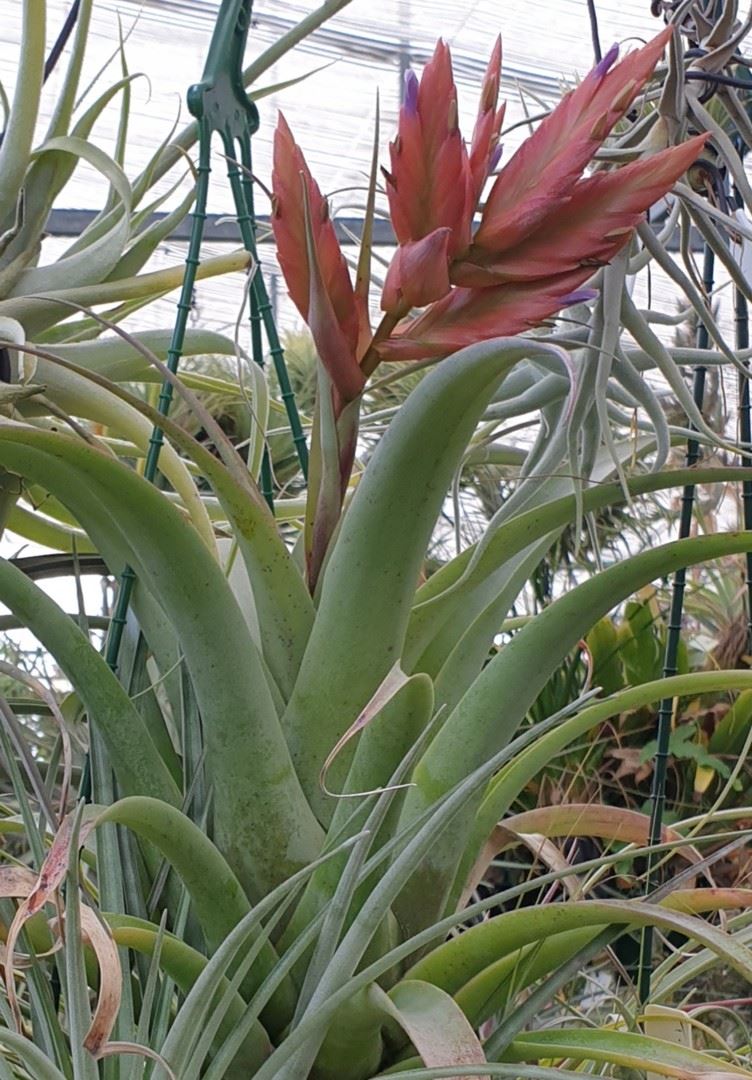
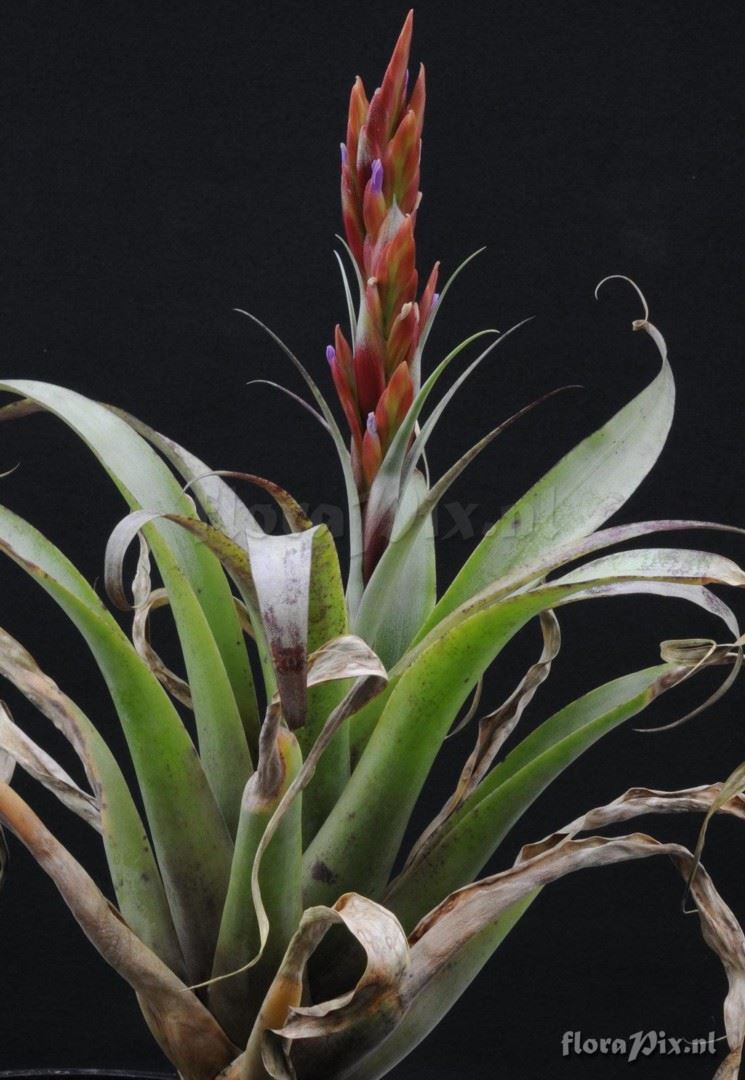


| Chris Larson 12/20 aff. cajamarcensis ? |
Peter Tristram (from florapix) |
Chris Larson ... "Here is a plant collected by Mick Romanowski quite a few years ago. If I am not wrong, it was found at Llacanora, Peru. It is like a T. cajamarcensis on steroids. It was at one time diagnosed as TV. harmsiana, and is still in some collections in Australia under this name."
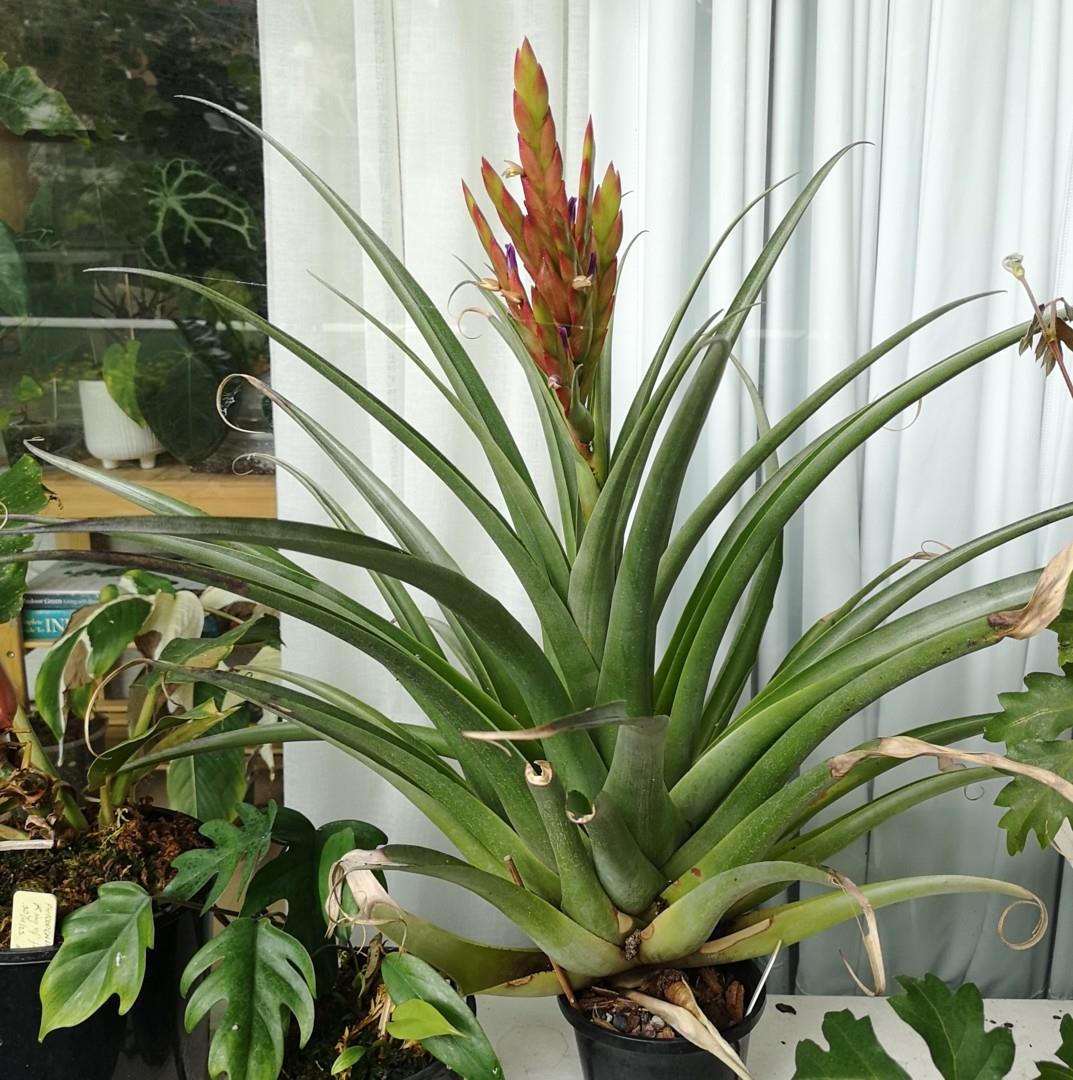

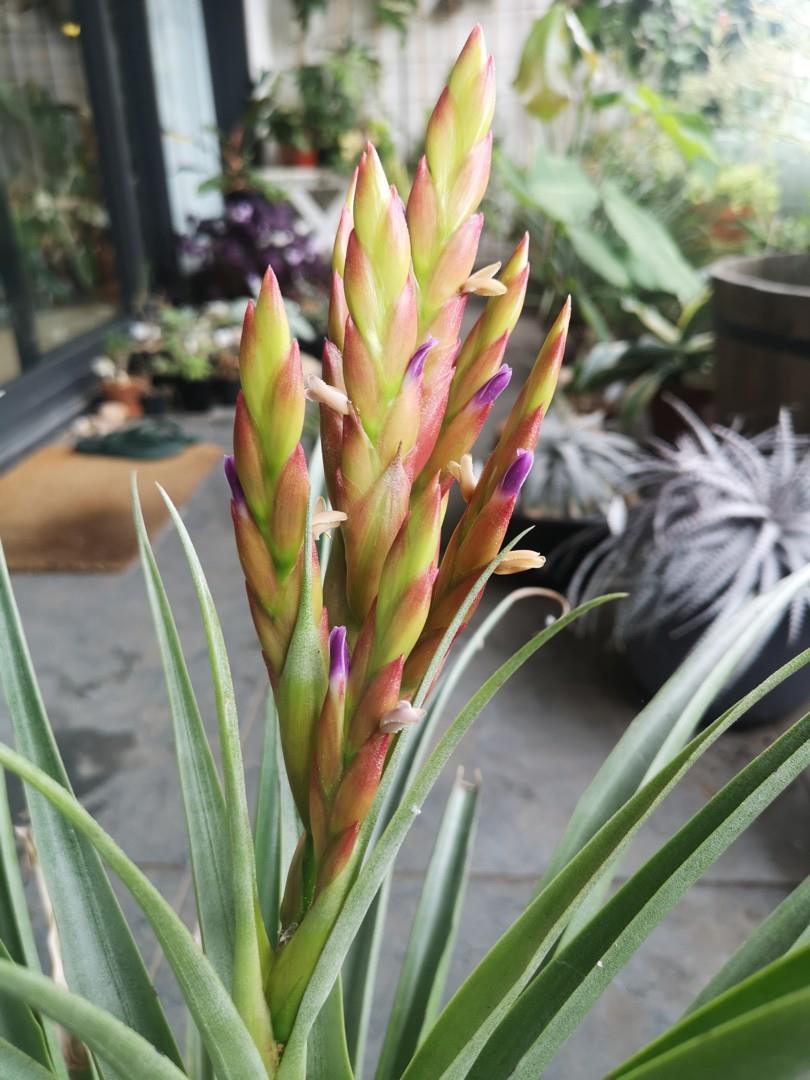
 Harold Kuan ... "I've got this beauty blooming, tagged as Vriesea aff. harmsiana.
Harold Kuan ... "I've got this beauty blooming, tagged as Vriesea aff. harmsiana.
It doesn't quite fit the description, but I've found the BinA entry and pictures of T. aff cajamarcensis to be on the dot. It's like a large version of T. cajamarcensis. The tag of mine does say it was collected by Mick Romanowski.
Just wondering if there has been any more light shed on this plant, or is it still aff. cajamarcensis?
Please excuse the ratty leaves! I also note, interestingly, the flowers never truly open or the stamens never exert (or at least I've never caught it happening). They're only visible when the flower turns brown. When still purple though, the flower is unusually hard!"
Peter Tristram ... "Nice specimen of T. cajamarcensis (aff?), collected near Llacanora, near Cajamarca. harmsiana grew there too. Michael didn't go with Mick and me to that site though.The roads in Peru that we travelled on are mostly tarred now, looking at Google Earth. It took us days to go quite short distances in 2003, but it was am adventure!
As you say, it's not harmsiana, so a label mix up.
Michael did obtain some plants from Mick Romanowski, this being one and Mick did sell some as harmsiana.
There was confusion on BinA too, but I think Ian sorted it out. I find it can be temperamental outdoors but grew well under plastic, though there are many clones. I sent a leaf sample to Michael Barfuss for sequencing."
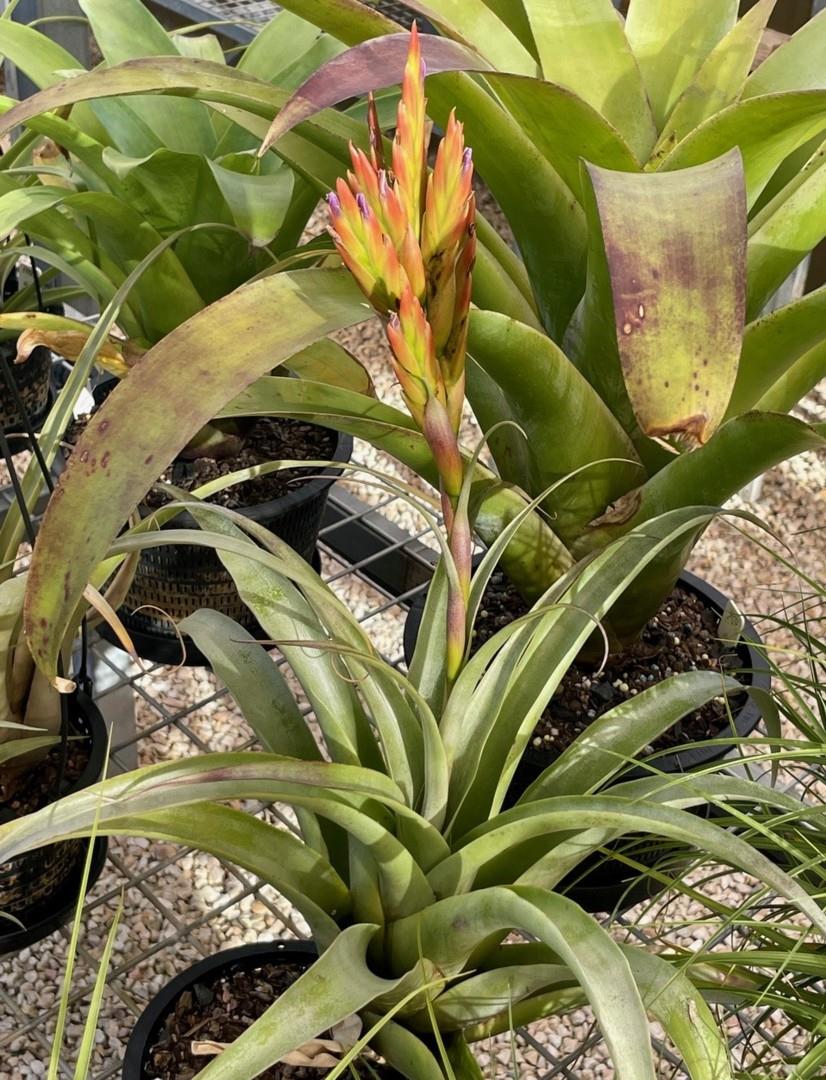
Tillandsia cajamarcensis W Rauh Sp nova Trop. Subtrop. Pflanz. 52: 43-6. 1985
Planta acaulis, florens usque ad 30 cm alta. Folia rosulam laxam plus minusve 15 cm altam et usque ad 20 cm latam formantia. Vaginae ovales, latae, cochleariformes, 8-9 cm longae, 5 cm latae, basi atrobrunneae, lepidotae. Lamina anguste triangula, longe attenuata, apices earum mox desiccantes et torivi, usque ad 20 cm longi, 3 cm lati utrimque dense cano-apresso-lepidoti, itaque folia canoalbido-calcareo-colorata. Scapus erectus rosulam foliorum paulum superans, usque ad 20 cm longus, 5 mm diametiens, teres, viridis, glaber. Phylla scapi subfoliata, semper internodiis longiora, erecta apicibus revolutis, vaginis scapum omnino involventia. Inflorescentia erecta vel leviter curvata, bipinnata spicis 3 erectis breviter cylindricis, 8 cm longa, 3 cm diametiens. Bracteae primariae spicis breviores phyllis superioribus similes, erectae plus minusve 5 cm longae, virides vel brunnescentes, basi glabrae, apicem versus cano-lepidotae. Spicae 5-6 cm longae, 1 cm latae, complanatae, breviter stipitatae, erectae, 4-5-florae. Bracteae florales distichae, dense imbricatae rhachim obtegentes, 2.5 cm longae, usque ad 1.4 cm latae, sepalis longiores, virides, lucentes, ecarinatae vel leviter carinatae, glabrae, tantum apice disperse lepidotae. Sepala 2.2 cm longa, 5 mm lata, membranacea nervo medio crasso, viridia, glabra, libera, posteriora carinata. Flores 3.5 cm longi. Petala violacea, basi alba, margine leviter undulata, se parum aperientia. Antherae paulo breviores quam petala. Stylus cum stigmatibus brevior quam filamenta.
Plant stemless, flowering to 30cm high, Leaves making a loose rosette ca. 15cm high and 20cm wide.
Leaf sheath oval, broad spoon shaped, 8 – 9cm long, 5cm wide, in the bottom half dark brown lepidote.
Leaf blade thin triangular, long acuminate, its tip drying early and curled like a watchspring, to 20cm long, and 3cm wide, both sides with dense grey appressed scales; leaf for that reason seemingly greyish white chalky.
Scape erect, overhangs the rosette a little way, to 20cm long, 5mm thick, round, green, naked.
Scape bracts leaflike, always longer than the internodes, erect, with rolled back tips, with the sheath wholly enveloping the stem.
Inflorescence erect to slightly bent, bipinnate, to 3 erect compound spikes, short cylindric, 8cm long, 3cm thick.
Primary bracts shorter than the spike, similar to the upper scape bracts, erect, more or less 5cm long, green to brownish, at the bottom naked, the tips grey lepidote.
Spike 5 – 6cm long, 1cm wide, complanate, short stemmed, erect, 4 – 5 flowered.
Floral bracts distichous, densely imbricate, covering the rhachis, 2.5cm long, 1.4cm wide, longer than the sepal, green, shiny, not keeled to weakly keeled, naked, scarce scattered scales at the tip.
Sepal 2.2cm long, 5mm wide, membranous, with a thicker midrib, green, naked, free, the posterior ones keeled.
Flower 3.5cm long.
Petals top half violet, at the bottom white, the edges weakly waved, opening a little way.
Stamens a little shorter than the petals.
Style with the lobes shorter than the filament.
Type Rauh 24 305a (Aug 1971) HEID
Habitat on rockfaces, together with T. humilis, 2800m, near Cajamarca, N. Peru.
The plant named from the locality of Cajamarca, is similar vegetatively to a small T. oroyensis coming from the same district. Yet grows rarely singly, mostly in dense clumps and is much larger (to 1.4m). In common with T. oroyensis, T. cajamarcensis has long flattened attenuate scape bracts, which are with long sheaths that envelop the scape. The inflorescence for T. oroyensis is bi or tripinnate to 50 cm long, the floral bracts at the same time are very laxly arranged, not keeled and naked, the sepals not keeled and the petals purple.
Photo by Peter Tristram. Walter Till considers that this can be considered the name because Rauh’s description was based on a depauperate specimen but Gouda was not so sure. See Photopix.
Updated 16/06/24








